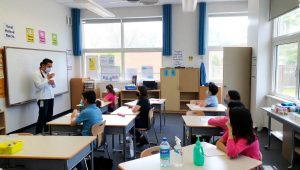
The COVID-19 pandemic has posed unprecedented challenges to education systems worldwide. As schools strive to balance learning continuity with health and safety, several countries have developed effective strategies to manage the risks of COVID-19 in educational settings. These global best practices serve as a valuable guide for schools and policymakers in creating safe learning environments while minimizing disruptions.
1. Implementing Comprehensive Health Protocols
One of the foundational strategies for managing COVID-19 in schools is the implementation of robust health protocols. These measures include regular hand hygiene, mask-wearing, and physical distancing. Countries like Japan and South Korea have set examples with their strict adherence to these protocols.
Handwashing stations are strategically placed in schools, and students are encouraged to wash their hands frequently. Masks are mandatory in classrooms, and social distancing is maintained by rearranging seating and limiting class sizes. Regular cleaning and disinfection of shared spaces and surfaces further reduce the risk of virus transmission.
2. Leveraging Technology for Hybrid Learning
To ensure continuity of education during school closures or reduced attendance, many countries have embraced hybrid learning models. For example, Finland and Singapore have integrated online and in-person teaching to accommodate varying circumstances.
Students alternate between attending school physically and participating in virtual classes from home. This approach not only reduces crowding in schools but also equips students with digital skills. Governments and schools have also provided devices and internet access to ensure that all students can benefit from online learning.
3. Routine Testing and Contact Tracing
Routine testing and efficient contact tracing have proven to be effective in controlling outbreaks in schools. Germany and New Zealand have implemented systematic testing for students and staff, allowing for early detection of cases.
Once a positive case is identified, contact tracing is swiftly conducted to identify and isolate close contacts. Temporary closures of specific classrooms or sections, rather than entire schools, help minimize disruptions while containing the virus.
4. Vaccination Campaigns for Students and Staff
Vaccination has become a cornerstone in the fight against COVID-19. Countries like the United States and Canada have prioritized vaccinations for school staff and eligible students to create safer school environments.
In addition, some schools have become vaccination centers, making it convenient for students and their families to receive the vaccine. High vaccination rates in school communities contribute significantly to reducing transmission risks and maintaining in-person learning.
5. Addressing Mental Health and Well-Being
The pandemic has taken a toll on the mental health of students, teachers, and parents. Recognizing this, countries like Australia and the United Kingdom have incorporated mental health support into their school reopening plans.
Counseling services, peer support programs, and teacher training in mental health awareness are some of the initiatives introduced to help students cope with stress and anxiety. Schools have also promoted mindfulness and physical activities to enhance emotional well-being.
6. Community Engagement and Transparency
Open communication with parents, teachers, and local communities has been critical in managing COVID-19 in schools. Countries such as Denmark and Taiwan have maintained transparency by sharing regular updates about case numbers, safety measures, and changes to school operations.
Engaging the community in decision-making processes fosters trust and cooperation. Parents and teachers feel more confident about returning to schools when they are involved and informed.